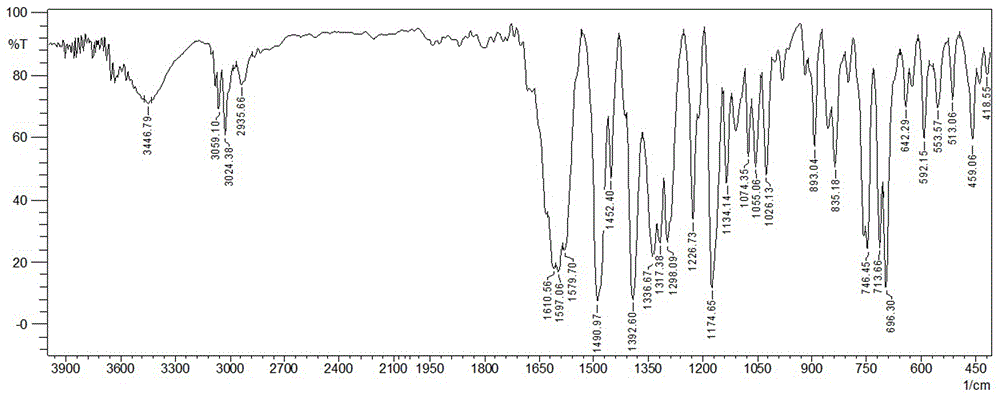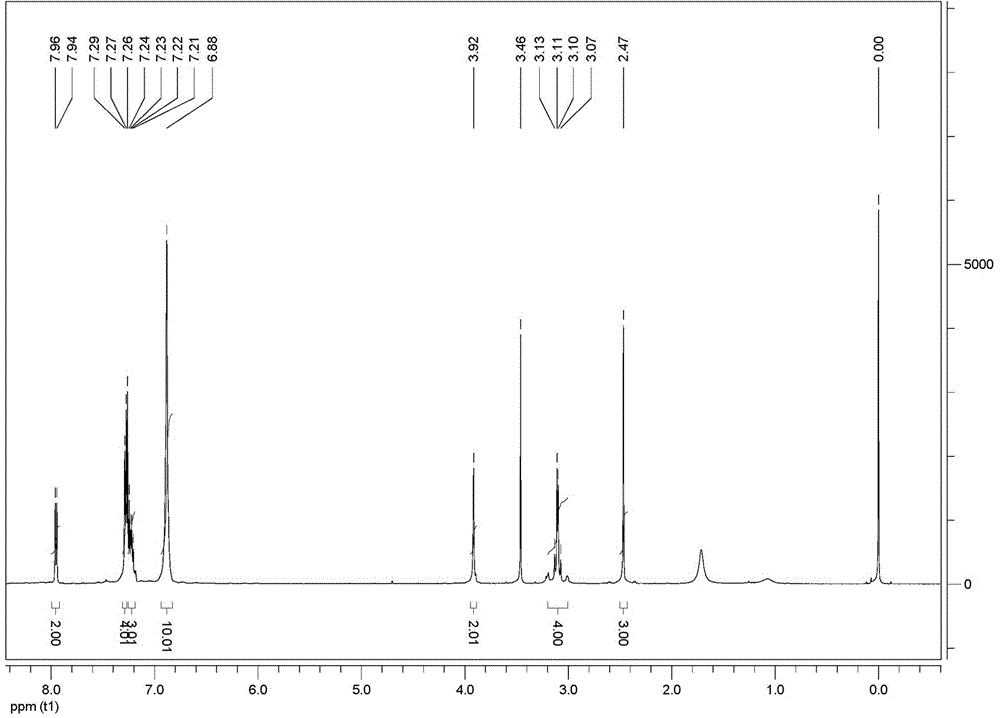2-Oxo-3-phenylpropionic acid p-methylbenzoyl hydrazone dibenzyltin complex, and preparation method and application thereof
A kind of technology of methylbenzoylhydrazone dibenzyltin and phenylpropionic acid, applied in 2-carbonyl-3-phenylpropionic acid p-methylbenzoylhydrazone dibenzyltin complex and preparation and application thereof It can solve the problems of undiscovered compounds and other problems, and achieve the effects of simple preparation method, low cost and good anticancer activity
- Summary
- Abstract
- Description
- Claims
- Application Information
AI Technical Summary
Problems solved by technology
Method used
Image
Examples
Embodiment 1
[0042] Preparation of 2-carbonyl-3-phenylpropionic acid p-methylbenzoylhydrazone dibenzyltin complex:
[0043] Add 0.372g (1.0mmol) dibenzyltin dichloride, 0.150g (1.0mmol) p-toluic hydrazide, 0.195g (1.05mmol) sodium phenylpyruvate and 15mL in a 100mL three-necked flask with nitrogen protection Solvent anhydrous methanol, react for 8 h at a temperature of 50~65℃, cool, filter, and control the solvent to volatilize and crystallize at 20~35℃ to obtain yellow transparent crystals, namely 2-carbonyl-3-benzene 4-methylbenzoyl hydrazone dibenzyl tin complex with propyl propionate. Yield: 75.6%. Melting point: 115~117°C (dec).
[0044] Elemental Analysis (C 64 H 64 N 4 O 8 Sn 2 ): Calculated value: C 61.27, H 5.14, N 4.47; measured value: C 61.30, H5.12, N 4.40.
[0045] FT-IR (KBr, ν / cm -1 ): 3446, 3059, 3024, 2935, 1610, 1597, 1490, 1452,1392, 1336, 1298, 1174, 1134, 1226, 893, 835, 746, 713, 696, 642, 592, 553,513, 459, 418.
[0046] 1 H NMR (500 MHz, CDCl 3 , δ / ppm): 7.95 (d, J =7.7...
Embodiment 2
[0051] Preparation of 2-carbonyl-3-phenylpropionic acid p-methylbenzoylhydrazone dibenzyltin complex:
[0052] Add 0.372g (1.0mmol) dibenzyltin dichloride, 0.158g (1.05mmol) p-toluic hydrazide, 0.214g (1.15mmol) sodium phenylpyruvate and 35mL in a 100mL three-necked flask with nitrogen protection Solvent anhydrous methanol, react for 5 h at a temperature of 50-65°C, cool, filter, and control the solvent to volatilize and crystallize at a temperature of 20-35°C to obtain yellow transparent crystals, namely 2-carbonyl-3-benzene P-methylbenzoyl hydrazone dibenzyl tin complex. Yield: 77.5%. Melting point: 115~117°C (dec).
[0053] Elemental Analysis (C 64 H 64 N 4 O 8 Sn 2 ): Calculated value: C 61.27, H 5.14, N 4.47; measured value: C 61.30, H5.12, N 4.40.
[0054] FT-IR (KBr, ν / cm -1 ): 3446, 3059, 3024, 2935, 1610, 1597, 1490, 1452,1392, 1336, 1298, 1174, 1134, 1226, 893, 835, 746, 713, 696, 642, 592, 553,513, 459, 418.
[0055] 1 H NMR (500 MHz, CDCl 3 , δ / ppm): 7.95 (d, J =7.7 Hz...
Embodiment 3
[0060] Preparation of 2-carbonyl-3-phenylpropionic acid p-methylbenzoylhydrazone dibenzyltin complex:
[0061] Add 1.860g (5.0mmol) dibenzyltin dichloride, 0.765g (5.1mmol) p-toluic hydrazide, 1.023g (5.5mmol) sodium phenylpyruvate and 25mL in a 100mL three-necked flask with nitrogen protection Solvent anhydrous methanol, react for 20 h at a temperature of 50-65°C, cool, filter, and control the solvent to volatilize and crystallize at a temperature of 20-35°C to obtain yellow transparent crystals, namely 2-carbonyl-3-benzene 4-methylbenzoyl hydrazone dibenzyl tin complex with propyl propionate. Yield: 77.8%. Melting point: 115~117°C (dec).
[0062] Elemental Analysis (C 64 H 64 N 4 O 8 Sn 2 ): Calculated value: C 61.27, H 5.14, N 4.47; measured value: C 61.30, H5.12, N 4.40.
[0063] FT-IR (KBr, ν / cm -1 ): 3446, 3059, 3024, 2935, 1610, 1597, 1490, 1452,1392, 1336, 1298, 1174, 1134, 1226, 893, 835, 746, 713, 696, 642, 592, 553,513, 459, 418.
[0064] 1 H NMR (500 MHz, CDCl 3 , δ / ppm...
PUM
 Login to View More
Login to View More Abstract
Description
Claims
Application Information
 Login to View More
Login to View More - R&D
- Intellectual Property
- Life Sciences
- Materials
- Tech Scout
- Unparalleled Data Quality
- Higher Quality Content
- 60% Fewer Hallucinations
Browse by: Latest US Patents, China's latest patents, Technical Efficacy Thesaurus, Application Domain, Technology Topic, Popular Technical Reports.
© 2025 PatSnap. All rights reserved.Legal|Privacy policy|Modern Slavery Act Transparency Statement|Sitemap|About US| Contact US: help@patsnap.com



